Biblical Magi
![]()
This article is about the figures of the Christian tradition. For the feast of the same name, see Apparition of the Lord; for other meanings, see Epiphany (disambiguation).
As Magi or Wise Men from the East, Christian tradition refers to the "Magi" (in the original Greek Μάγοι, Magoi, literally "magi") mentioned in the Christmas story of Matthew's Gospel (Mt 2 EU), who were led to Jesus by the star of Bethlehem. They are not called "Magi" in the New Testament, nor is there any indication of their number. This information comes from an extensive creation of legends, which only began in the late 3rd century. The names Caspar, Melchior and Balthasar, common in the Western Church, are first mentioned in the 6th century. In contrast, a 7th century Syriac source from Edessa in Upper Mesopotamia and others speak of twelve Persian kings.
In the Catholic Church, the "three kings" are venerated as saints. Their Solemnity is the Feast of the Epiphany on 6 January. In the Protestant churches, too, the wise men are commemorated on Epiphany. In the Orthodox Churches, however, their feast is celebrated together with Christmas on December 25 of the Julian calendar.
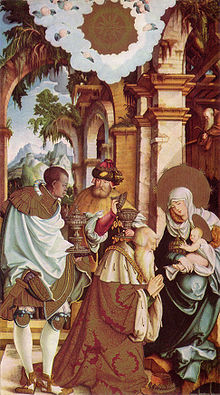
Epiphany painting by the Master of Meßkirch, c. 1538
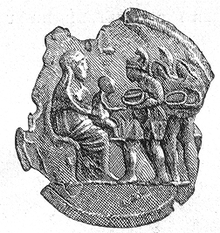
Adoration of the Magi, bronze plaque, 4th century (Vatican Museums, Rome)

Adoration of the Magi, capital, exhibited in the chapter house of Saint-Lazare d'Autun Cathedral, 12th century.

Sandro Botticelli: Adoration of the Magi, tempera on wood, c. 1475 (Galleria degli Uffizi, Florence)
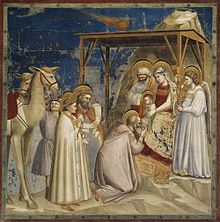
Giotto di Bondone: Adorazione dei Magi, fresco in the Cappella degli Scrovegni (Padua) depicting a comet, c. 1305
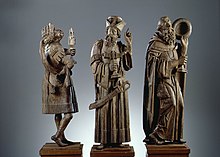
Magi, oak wood, c. 1490, Germanic National Museum in Nuremberg
Exegesis and biblical references
The second chapter of the Gospel of Matthew (Mt 2 EU), in the context of the narrative of the birth of Jesus Christ in Bethlehem, reports the worship of the newborn by Μάγοι ἀπὸ ἀνατολῶν (Greek, Mágoi apὸ anatolôn, "Magi from the East"). It says: "When Jesus had been born in Bethlehem in Judea in the time of King Herod, astrologers from the East came to Jerusalem and asked, 'Where is the newborn King of the Jews?' We have seen his star rise and have come to pay him homage.'"
The term mágos (Gr. Sing. μάγος, Plur. μάγοι; from Old Persian maguš) was generally used in Greek for a sorcerer and astrologer, but especially for the Zoroastrian priestly caste, which originally went back to the Median priestly tribe of the Mager, mentioned in Herodotus, Strabon, and Philon of Alexandria, among others. Then, in the Iranian Arsacid Empire (c. 250 BC to 224 AD), all Zoroastrian priests were called magicians (moġ); they enjoyed a reputation among Greeks and Romans for being particularly good soothsayers and astrologers. Therefore, Persian or also Chaldean astrologers could be meant in the biblical text. In older research, it was sometimes argued that these magicians could have been influenced by the Jewish community in Babylon. According to the general view of theological exegesis, they represent the world of the Gentiles and are looking for the newborn "King of the Jews" (Mt 2:2 EU), a term used in Matthew only by Gentiles (cf. Mt 27:11, 29, 37 EU); the Jews in Matthew's Gospel use instead exclusively the term "King of Israel" (Mt 27:42 EU).
According to Matthew the magicians observed the rising of a star that announces the birth of a king (Mt 2,2 EU). Here a personal star is thought of in the sense of a celestial phenomenon observed by them. Associations to the star can be found both in the understanding horizon of the pagan ancient environment (Virgil's Aeneid 2,694) and in the Jewish environment (cf. the Balaam's word about a rising star in Israel Num 24,17 EU or also possibly the wandering pillar of fire in Ex 13,21 EU). Whether the story was based on an actual phenomenon in the starry sky around the turn of time (a certain planetary constellation, a supernova or a comet would be conceivable) is disputed among astronomers and, according to the opinion of many theologians, "misses the primarily symbolic content of the star as a question".
In verse 3-8 the magi first come to Jerusalem, as the capital obvious birthplace of a king of the Jews. Here the reaction of the political and religious aristocracy to the birth of the Messiah is described: "they were terrified" (v.3). In v.8, King Herod even instructs them to return and tell him the exact location of the child - a preparation for the narrative of the infanticide in Bethlehem (Mt 2:16-18 EU). Thus Matthew already points to the central motif of the rejection of the Messiah by his own people in the introduction of the Gospel.
In verse 9 the wise men follow the star again, which is only now described as a guiding wandering star. It goes before them to Bethlehem and stops there. In contrast to the Gospel of Luke ("manger" without statement about the building, Lk 2,7 EU) it is an ordinary "house" in Matthew (v.11). Verse 10-11 are designed as a contrast to the fright of the people in Jerusalem: The magi are overjoyed - "they rejoiced greatly with great joy" - and offer their gifts: Gold, frankincense, and myrrh (verse 11). This verse refers to several Old Testament passages:
The pilgrimage of the nations to Zion in Psalm 72:10-15 EU:
"10The kings of Tarshish and of the islands bring gifts; the kings of Sheba and Seba come with gifts. 11All kings must pay homage to him, all peoples must serve him. [...] 15Live, and gold from Sheba shall be given to him!"
In the book of Isaiah 60:6 EU:
"All come from Sheba, bringing incense and gold, and proclaiming the glorious deeds of the Lord."
And in Song of Songs 3:6 EU:
"Who is she that cometh up out of the steppes in pillars of smoke, clouded with myrrh and frankincense, with all the perfumes of merchants?"
In addition, Matthew uses each gift individually as a testimony to the Messiahship of Jesus: gold as the appropriate gift for the newborn king; myrrh, a medicinal plant used to prepare medicine, on the one hand as a gift for the physician and healer ("Savior") sent by God, and on the other hand, with reference to Ex 30:22-33 EU, as well as the incense assigned to the area of the temple as a gift for the future high priest of Israel.
Another reference to myrrh is offered by the Gospel of John 19:39 EU, where it is said that Nicodemus brought about 100 pounds of myrrh mixed with aloes to Jesus' burial. The view that the King's myrrh belongs in this context is encountered very early. In a text attributed to Beda Venerabilis, the model for which may have been a Greek painter's manual, we read: "Balthasar [...] per myrrham filium hominis moriturum professus est" ("Balthasar indicated by the myrrh the future death of the Son of Man"). In this sense Friedrich Spee wrote around 1623: "die Myrrh' auf seine Menschheit wies". The myrrh is then not a sign for the healer, but a sign for the mortal man who is laid in the grave embalmed with myrrh. This idea is also expressed in the antiphon to the Benedictus of Lauds on 7 January. There the three wise men bring "gold to the great king, incense to the true God and myrrh for his burial". The same thought can be found in the hymn "Ein Stern ist aufgegangen" by Guido Maria Dreves: The wise men brought "incense to the heir of God, gold to the King's child, myrrh to him who wanted to die for us on the cross".
Matthew 2,12 EU still makes sure that the wise men do not become accomplices of Herod and betray Jesus. With this they disappear from the gospel of Matthew, "there is no further interest in them".
Relics
The origin and history of the relics of the Magi have only been handed down in legendary form until the 12th century. According to this, St. Helena, the mother of Emperor Constantine, is said to have found the bones of the Magi on a pilgrimage in Palestine around the year 326 and taken them with her. According to a 12th-century legend, Bishop Eustorgius of Milan († c. 350) received the relics as a gift from the emperor a few years later and personally transferred them to his episcopal see of Milan. It is in the Basilica of Sant'Eustorgio in Milan, dedicated to this bishop, that the relics of the Magi can first be historically traced. In 1158, in the face of the first siege of Milan by Frederick Barbarossa, they were moved from the basilica outside the city walls to the bell tower of the church of San Giorgio al Palazzo, located in the city.
After the conquest of Milan (1162), the imperial chancellor and Archbishop of Cologne Rainald von Dassel received the bones as a gift from Emperor Barbarossa in 1164. This also expressed a political intention. The bones of what might be called the "first Christian kings" were to give Barbarossa's empire a sacral justification without dependence on the Pope. On 23 July 1164 the relics reached Cologne, where they are still venerated today in the shrine of the Three Kings, built around 1200. The great rush of pilgrims to the shrine was the reason for starting the construction of Cologne Cathedral in 1248 in place of the smaller Hildebold Cathedral. In 1903, part of the relics were returned to the Milan Basilica of Sant'Eustorgio.
In the Cappella dei Magi of the Basilica of Sant'Eustorgio there is still the monumental pediment sarcophagus from late Roman times in which the relics are said to have been brought to Milan and from which they were taken in 1164. It shows the Star of Bethlehem on the roof and below it the Latin inscription "SEPULCRUM TRIUM MAGORUM" (Tomb of the Three Wise Men).
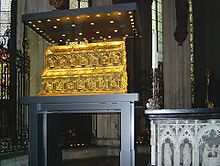
Epiphany shrine in Cologne Cathedral

Cappella dei Magi in the Basilica di Sant'Eustorgio in Milan
Search within the encyclopedia